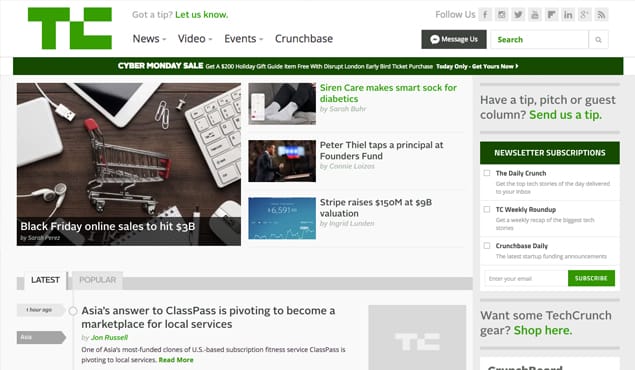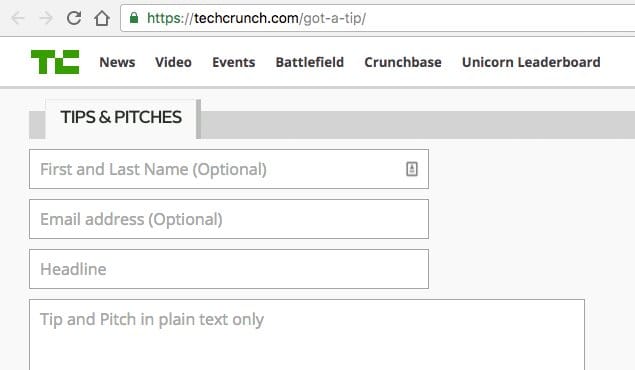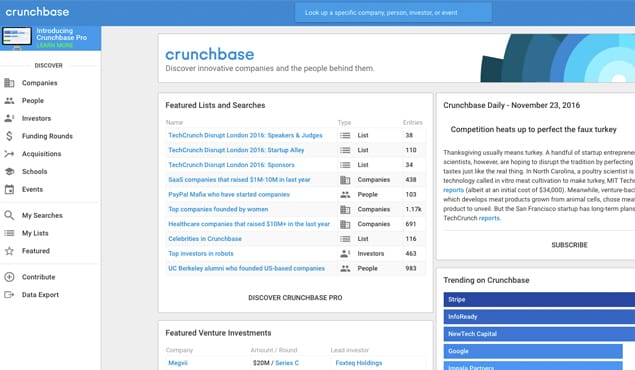For some writers, TechCrunch stands as a mecca in the technology world. If only you could publish there, right? You’d have it made.
Apple and Samsung would send you all their products six months in advance, you’d get to drive Tesla’s newest cars, and the latest in human-like robotics would just show up at your doorstep, unannounced, for review.
Dreams are fine, but that’s not going to happen. Even if it were, first you’d have to get published at TechCrunch, which is a process that takes diligence, patience, and a good deal of writing skills.
The good news is that writing a guest post for TechCrunch is not impossible. The site has a very active, robust community built entirely around its guest posts and guest columns, which means you can definitely get published. People get published all the time.
The bad news is that everyone else in the technology and writing world knows this. You’re competing against them. This doesn’t have to be a negative; you can use it as fuel.
The Universal Truths About Guest Posts
While there are some very specific aspects of submitting a guest post to TechCrunch, the first thing I want to explore is the more universal truths. These stand for pretty much any guest post pitch process at major blogs, be they Entrepreneur, Forbes, or Mashable.
1. Be on Topic
You’d think it goes without saying, right? You have to write articles on the specific topics of the blog you’re applying to. In the case of TechCrunch this means “stories that live at the intersection of technological innovation and social change.”
Yes, that’s a quote lifted from their website, and yes, it’s pretty far reaching.
TechCrunch is a blog primarily focused on technology, startups, entrepreneurship, software applications, and all the hype that goes with these topics. If you write in these fields, you’re golden.
However, it also accepts a wide range of other topics as long as they have a technology-bent. This could be travel oriented, like the best way to get WiFi in foreign countries. It could also be political, like the tech behind electronic voting systems.
As long as technology is somewhere in the heart of your piece, TechCrunch will take a look.
2. Be Unique
The first step only works when you execute the second step — be unique — perfectly. This is as true for TechCrunch as it is any other major blog.
No editor wants to publish an article that says the same old shit. Therefore, if you submit an article that basically says the same shit as other articles on the website, even if it’s in a slightly new context or with a different tone, you won’t get published.
This step is much harder to get a handle on because there is so much content coming out these days. You have to diligently read TechCrunch to know what it hasn’t talked about. Then you have to be knowledgeable enough on a given topic to say what hasn’t been said before, all while saying it eloquently.
This factor in getting published is often why writers, especially up and coming writers trying to guest post for big websites, are frazzled. You must be very well read, up on the times, and able to write quality quickly in order to get there first.
If you don’t, you can almost guarantee someone else will.
3. Be Professional
The last step that’s true across the board for guest post submission tactics — and especially true for TechCrunch — is to be professional. Make sure you email courteously, respect the writer’s or editor’s time, and don’t harass anyone.
I’ll get more into this below, but it’s worthy of noting now. Always be professional in your communication because the moment an editor thinks, “Good article, but this person is terrible to work with,” you will be out of luck.
Submitting a Guest Post to TechCrunch
It’s time to get specific, and you’re in luck. TechCrunch has one of the more approachable, outlined methods of guest posting compared to other sites. I’ll explore each of these elements below.
You’re not the first person to wonder how to submit a guest post to TechCrunch (and get published). So many people have inquired that, over the years, various editors have posted articles to help out the general writing populace.
The first method is the official tip page by which you can submit a tip or guest post pitch. For tips and pitches — for those wondering, yes, a pitch is a guest post pitch — you can use the email [email protected] or the form provided in the link above.
You can see a space for your name and email, the headline, and then the pitch itself. In general TechCrunch does not expect a full post in this form, just a pitch, which means what you want to write about the topic, what your angle on that topic is, and what your expertise is in that field.
While this is an acceptable method of submission, you can bet the inbox for that email is overflowing. It’s likely so full that editors probably have an intern sort through it.
I don’t recommend submitting this way, but you certainly can.
Crunch Network
TechCrunch makes a distinction between a guest poster and a guest columnist. In reality they aren’t very different — the guest columnist is more of an official member of the community, and is set up to post multiple articles as time goes on.
The guest columnist is the one you want to submit through if you’re going the traditional route.
The Crunch Network is a program pioneered in 2014, in which TechCrunch formally announced it was taking on more guest writers in specific topics. These topics would be laid out clearly by month, be longer form and more in-depth, and get published on the weekend for high readership.
When you travel to the Crunch Network you’ll see a number of articles on it, but scroll down. You’ll find the themes for the whole year — it will be broad topics that illustrate what TechCrunch is looking for month by month, like “Transforming Wealth” and “Spaces and Places.”
These are broad enough for lots of leeway, but push an overall editorial plan to help writers (and TechCrunch) have a focus as the year goes on.
This plants a huge flag for you, as a writer. You can use these to plan posts, do legwork and research ahead of time, and figure out exactly what you want to write about.
Submitting in the Crunch Network
Below the tiles that show the topics you’ll see a more formal submission area. This is much more involved than the Tips and Pitch form, and therefore is a better place to submit.
You’ll see all the required information, like your name, company, a bio, and article headline. You’ll also submit the full text of your article here. Finally, you’ll need to have a Crunchbase Profile URL, which basically means you are signed up in the Crunch Network.
All of this streamlines the acceptance process for TechCrunch.
1. Follow the Directions
I won’t repeat all of the very clear directions TechCrunch lists in the side-bar of this application form.
In short, follow it to a T. The quickest way to get rejected by a company and put a bad taste in the editor’s mouth is to disregard their instructions. They want hyperlinks a certain way, single spaces after a period, and other specifics that are critical to your getting accepted.
Be professional here, and don’t waste their time.
2. Connect with a Writer or Editor
Going the official route can certainly work, and TechCrunch is unique in that it checks the Crunch Network submissions diligently.
However, getting published there is still wading through a slush pile, and nobody wants to do that if there are other options available.
A time-tested and semi-unofficial way to get your voice heard is by connecting with a writer or editor directly, bypassing the entire slush pile from the start.
Who to Connect With
TechCrunch publishes a massive amount of articles. There’s sure to be something on the site that is right up your alley in terms of what you want to write. Find the articles that are similar to the topic you want to write about, to the tone you want to write in, and to the overall perspective you are looking for.
These writers will be your springboard into guest posting for TechCrunch.
After creating list of writers that are similar to you on TechCrunch, narrow them down in a spreadsheet. Get contact information, what sites they write for, social handles, and how much traffic they seem to get.
Then get ready to either get in touch directly or indirectly.
First, though, make sure to select a writer that has a lengthy history of publications at TechCrunch. This way, when you do get in touch, you’ll be reaching somebody that has a solid report with the editorial staff at TechCrunch, not a newbie who can’t help you.
Indirect
This is a longer game, and is only necessary if you’re not quite ready to pitch a full article. Start commenting on this writer’s articles. Interact on social media, get noticed in any way you can.
This builds a relationship with the writer indirectly so that when you do email them, directly, it won’t take them by surprise.
Direct
If you know exactly what you want to write, or are pretty confident in your abilities and viewpoint, go the direct route. Or, of course, if you’ve done the indirect route and are now ready to reach out, do so.
Often TechCrunch writers will have a profile on the site with an email you can reach. Use this email to get in touch. You could politely ask for their editors email address, or how they became a writer for TechCrunch. If you’re nice, they might just share that information with you.
It’s alright to cold-email, but make sure you put things in context so it makes sense. You should include:
- Your name and experience
- Why you emailed this person in particular
- You article headline, concept, and the article itself pasted into the email
- Ask them to look at it or forward it to an editor
- Professional demeanor
This may feel awkward, like you’re reaching out to potential competition and asking for special treatment. However, you need to remember that everybody started out somewhere, and if you throw out a large enough net and if you are polite, somebody will most likely respond. You may just have that unique combination of perspective and skills that drives more traffic to TechCrunch, which is what everyone wants for the organization.
Summing Up
Submitting to TechCrunch is not rocket science (unless you’re writing an article about rocket science). The publication actually has one of the more active and open methods of accessing one-off guest posters and regular contributors, which is great news for you.
You must remember, above all else, to submit unique content. The majority of guest posts get denied because TechCrunch has already published an article that is similar. What are you saying that is new?
By submitting only unique content you show a dedication to the company and an ability to think critically, which will lead to future articles as well.
Connect with a writer if you can, or submit through the Crunch Network.
Lastly, keep trying. Maintain your professional demeanor and get better with each submission, but don’t stop simply because you got rejected. Find out what went wrong, what you can do better, and then do those things.
 ContentPowered.com
ContentPowered.com










